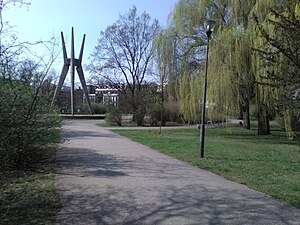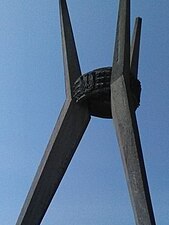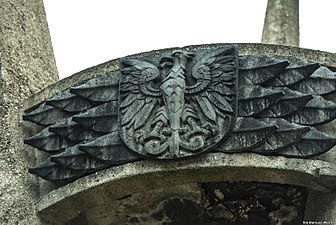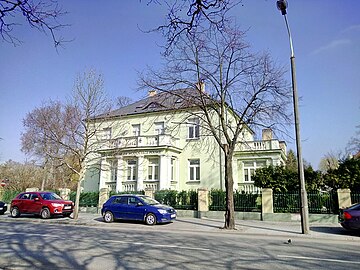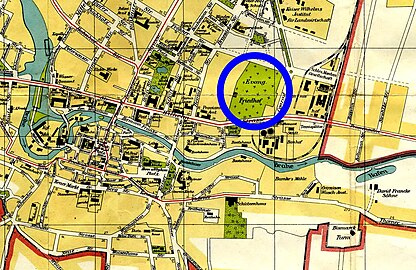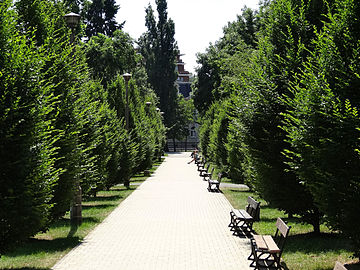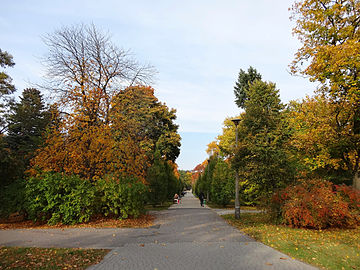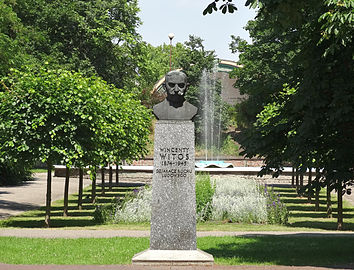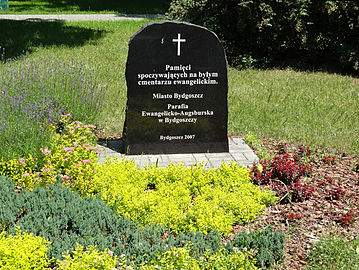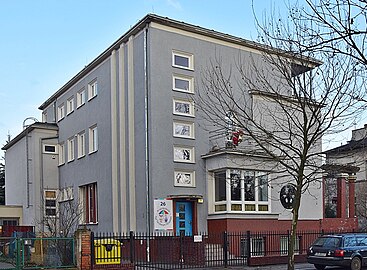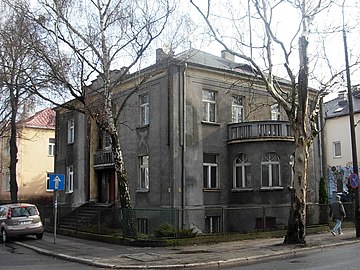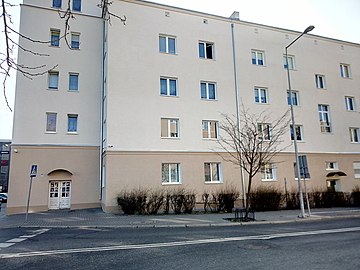Markwarta Street, Bydgoszcz
| Bydgoszcz | |
|---|---|
 Street view westward | |
 Markwarta Street highlighted on a map | |
| Native name | Template:Lang-pl Error {{native name checker}}: parameter value is malformed (help) |
| Namesake | Father Ryszard Markwart |
| Owner | City of Bydgoszcz |
| Length | 450 m (1,480 ft) |
| Width | ca. 10 m |
| Area | Downtown district |
| Location | Bydgoszcz, |
| Construction | |
| Construction start | Late 1920s[1] |
| Completion | Early 1950s |
Markwarta street is located in the downtown district of Bydgoszcz, Poland. Situated in its path are two green areas and several villas built during the Polish interwar period.
Location
East-west street track extends Krasińskiego Street to the east. It ends while meeting Ossoliński avenue and Piotrowskiego Street at Ossolińskich roundabout.
History
The axis has long been visible on Prussian maps of Bydgoszcz, mainly as an eastbound track prolonging Frönerstraße (today's Krasińskiego Street), but was never been associated with a naming.
The first city book listing Markwarta street dates back to 1928,[1] associated with the creation of the Idyll area (Template:Lang-pl), set north of Markwarta street. In the 1910s, Sielanka area plans, designed as a city-garden, were drawn by German architect Josef Stübben,[2] but due to WWI the project only took off in the 1920s, hence the appearance of Markwarta street on the maps at this time.
The street is named after Ryszard Markwart (1868-1906), a Polish priest who was a nationalist activist and head of Bromberg parish from 1899 till his death.
Main edifices
Square of Lieutenant Leszek Biały
This green area is what is left from Sielanka's urban plan developed in the 1910s by German architect Josef Stübben.[3] At the time this part of the city had not been touched by urban growth, as Gdańska or Dworcowa streets could have been at the end of the 19th century. Sielanka district never included this square as, at the time, it was a property of Province of Posen (Template:Lang-ger) and not owned by the municipality. After the rebirth of Poland in 1918, the area was declared to be constructed, but no project was ever completed. In the 1960s, a memorial has been built up to celebrate the Millennium of the Polish State (Template:Lang-pl). Designed by Polish artist Stanislaw Lejkowski on July 22, 1967,[4] the project has never been entirely completed. In 2011, the city had even projects to demolish it, but it turned out to be too expensive.[5]
The site has been given the name Lieutenant Leszek Biały in November 2013.[6] Leszek Biały was a hero of the Home Army during the Second World War. Under the code name Jakub, he was arrested in February 1945 by members of soviet controlled Ministry of Public Security and was murdered during interrogations on March 3, 1945. In October 1956, his remains were discovered in the basement of the UB building at No.4.[7] A renovated stone memorial to honor Leszek Biały and his heroic comrades has been unveiled in 2013.[8]
-
The square and its monument c. 1975
-
The square from the street
-
The unachieved monument to the Millennium of the Polish State
-
Detail of the crown
-
Stone memorial to Leszek Biały
Multidisciplinary hospital at No.4/6
1947[9]
The hospital was established on November 7, 1947 as a healthcare institution dedicated to Provincial Office of Public Security, Urząd Bezpieczeństwa Publicznego or UBP:[10] initially, it consisted of a building at No.6 and two floors of the abutting building at No.4 where was located Bydgoszcz UBP at the time. In the years 1966-1967, a link was built between the No. 4 and 6. After the expansion of the late 1980s, the hospital had 127 beds. It provided medical care for the benefit of the Ministry of Interior employees until 1990. Since the fall of communism, it provides services to all patients without any professional restrictions. Today the facility provides medical services in the field of basic health care, such as Dental and Oral Medicine, rehabilitation, occupational medicine, laboratory diagnosis and medical imaging.
The dark past of No.4 as UBP building has been highlighted in 2019, by the uncovering of a memorial plaque.[11]
-
View from the street
Villa at 2 Kasprowicza street, corner with Markwarta street
1927-1930,[1] by Bronisław Jankowski[3]
Polish national style
Teodor Krüger, an engineer, was the first owner of this house. He did not live there, but at Krasińskiego Street 4.[1] Today, the villa houses the Polish Foundation for the Protection of Water Resources (Template:Lang-pl).
Main highlight of the edifice is the facade on Markwarta, which bears an avant-corps supported by columns, topped by a balcony fenced with a balustrade.
-
View from Markwarta street
-
View from Kasprowicza street
-
Main elevation
-
Balcony adornment
Ludowy Park
6,42 ha
1953
The park is located between the streets Jagiellońska, Piotrowski and Markwart, on a 250 by 275 m area mainly lying in the back of the Youth Palace. It was named in memoriam of Wincenty Witos.
Ludowy Park (People's Park) was founded at the place of an ancient cemetery,[12] dating back to 1778, the oldest and largest in the city.[13] In 1838 was built a house for the administrator, with a separate room for the morgue. In 1884, a cemetery was erected and in 1898 a massive brick fence, which survived after the liquidation of the cemetery.[13] Entrance was made through two wrought iron gates to Markwart street, leading to the chapel located in the middle of the graveyard. A large square with outgoing path, like spokes, divided the cemetery into quarters. A lot of different trees were growing there: oak, chestnut, European beech, downy oak, sessile oak, oak red, locust, birch, lime, common spruce, prickly spruce and white spruce, and near the house were 10 Catalpa bignonioides.[12] In 1938, 66 species of trees and shrubs were growing in the cemetery where a majority of German tombs could be found.[12]
After Bydgoszcz's liberation in 1945, the old cemetery was closed and transferred to the Lutheran cemetery in Zaświat Street.[13] The liquidation of the ancient graveyard was carried out in 1951-1952, the last bone exhumation to Zaświat street was held in 1956.[12] Many tombstones have been destroyed during the liquidation, along with sculptures, reliefs and catacombs. It has been the case for some famous people's tombstones:
- Theodor Gottlieb von Hippel the Younger (1775-1843);
- Carl and William Blumwe, owners of Factory of Machine Tools, where a copy of the sculpture of "Christ the Saviour" by Bertel Thorvaldsen was standing. This sculpture has been moved to the square by the Lutheran Church of the Savior in Bydgoszcz, it is today one of the most impressive religious monuments in the city.
Once the cemetery liquidated, a city park, named "People's Park" (Template:Lang-pl), has been set up on the very place, using part of the remaining elements of the gone necropolis.
In 1956, a concert shell has been erected with a capacity of 5000 people. This building replaced the amphitheatre erected in 1946 in Park Casimir the Great.[14] In addition to the concert shell, three blocks of flats on the western edge of the park, and pavilions in the east were constructed. In 1974, at the southern edge of the park has been built the "Youth Palace".[13] On June 3, 1984, at the initiative of People's Party, the park has been given the name of Wincenty Witos: his bust has been realised by Witold Marciniak and funded by Bydgoszcz Voivodeship's Polish People's Party. Between the monument and the concert shell, a round pool with a gushing summer fountain has been built.[13] In 2007 have been performed renovations of parkways, concert shell and park greenery. On April 24, 2007, a black granite obelisk commemorating the existence of the old cemetery has been unveiled in the south-east corner of the park, bearing the inscription:
City of Bydgoszcz
Lutheran Parish of Bydgoszcz
Bydgoszcz 2007"
Since 2018, a heavy revitalisation of the park is in progress, it will end in November 2019.[15]
-
1914 Map of Bromberg with the Lutheran cemetery (Evang. Friedhof)
-
View of a walkway
-
View of a walkway
-
The fountain
-
Monument to Wincenty Witos
-
Commemorating obelisk
-
Bertel Thorvaldsen's sculpture, moved to Bydgoszcz's Lutheran "Church of the Savior"
Villa at 7 Markwarta street
1927-1928,[1] by Józef Grodzki[3]
First landlord was Wawrzyniec Tabaka, an engineer, who lived at Królowej Jadwigi Street 3 (No.8a at the time).[1] Today, the villa houses the Provincial ambulance station (Template:Lang-pl).
A large avant-corps bulges forward on the main elevation, overlooked by an eyelid dormer. The villa was renovated in 2018-2019.
-
View from Markwarta street
-
Side view
-
Side view
Villa at 9 Markwarta street
1927-1929,[1] by Józef Grodzki[3]
Teoktysa Jeżewska, a retiree, is registered as first owner of the edifice in the early 1930s.[16]
The main feature of the villa is the canopied roof of the large avant-corps that juts out of the facade onto Markwarta street.
-
View from Markwarta street
-
Side view
Wacław Millner Villa at 11 Markwarta st.
1937-1938,[3] by Jan Kossowski
Wacław Milner was the owner of a mass production metal factory for bicycle, Wacław Millner or WMB, which flourished in the 1930s.[17] His plant was located at Mazowiecka street 29.[18] He had this villa realized by the famous Bydgoszcz architect Jan Kossowski in the late 1930s. Today, the building houses kinder garden N)26, Pod Tęczowym Parasolem - transl. Under the rainbow umbrella.
The edifice looks like a heavily fragmented solid, featuring many rectangle shapes, in the windows, the wide terrace or the pergola. The garden of the villa runs around the house and displays various sizes of rectangular ceramic tiles.
-
View from Markwarta street
-
Side view
-
Villa at No.11, with No.9 in the backdrop
Villa at 1 Sielanka street, corner with Markwarta street
1930-1933,[3] by Bolesław Polakiewicz
Ludwik Biały, a priest, is registered as the first owner of the villa.[16]
The house, though needing an overhaul, features typical geometrical shapes, including a massive avant-corps with a terrace on the main elevation.
-
Main elevation from Markwarta street
-
Villa at Sielanka 1, with Millner's villa in the background
Villa at 2 Sielanka street, corner with Markwarta street
1927-1928, by Bronisław Jankowski[3]
The first landlord is Mr Cacko, who did not lived in the house.[16]
The villa offers more attractive architectural details than its counterpart across Sielanka street. The modernistic body is emphasized by a large portal, flanked with two Tuscan type columns and the elevation on Markwarta street boasts a large circular avant-corps topped by a balustrade terrace.
-
View from Markwarta street
-
Round bay window
-
Main entrance
Villa at 11a Markwarta street
1970s
The villa has been erected in the 1970s, with respect to the Sielanka style which is present all around the area.
-
Main elevation from Markwarta street
-
View from the street
Buildings at 13/13a Markwarta st., 19-21 Piotrowskiego/20-22 Markwarta st.
These tenements stand at the end of Markwarta street. They have all been built in the 1930s and bear the mark of it:
- N°13/13a are located at Ossoliński Alley 1/3a;
- N°20-22 has been realized by Jan Kossowski in 1937/1938, for Józef Piecek, an engineer[19]
-
13/13a main elevation
-
Main elevation of 20 Markwarta
-
20 Piotrowskiego facade
-
Kossowski's ensemble at 19-21 Piotrowskiego/20-22 Markwarta
See also
- Bydgoszcz
- Krasińskiego street
- Staszica Street
- Ossoliński Alley in Bydgoszcz
- St. Vincent de Paul Basilica Minor in Bydgoszcz
- Piotrowskiego Street
- (in Polish) Ryszard Markwart
References
- ^ a b c d e f g Książka Adresowa Miasta Bydgoszczy : na rok 1928. Władysław Weber. 1928. p. 109.
- ^ Bydgoskie Centrum Informacji (2018). "Sielanka". visitbydgoszcz.pl. Bydgoskie Centrum Informacji. Retrieved 6 April 2019.
- ^ a b c d e f g Derkowska-Kostkowska, Bogna (1999). O zalozeniu Sielanki - bydgoskiego miasta ogrodu. Materialy do dziejow kultury i sztuki bydgoszczy T4. Bydgoszcz: Pracownia Dokumentacji i Popularyzacji zabytków Wojewódzkiego osrodja kultury w Bydgoszczy. p. 72.
- ^ "Pomnik Tysiąclecia Państwa Polskiego". visitbydgoszcz.pl. Bydgoskie Centrum Informacji. 2016. Retrieved 19 November 2017.
- ^ Idczak, Katarzyna (2 May 2011). "Co ze skwerem na Sielance?". expressbydgoski.pl. expressbydgoski. Retrieved 19 November 2017.
- ^ kd (25 November 2013). "Tablica upamiętniająca ppor. Leszka Białego wróciła na skwer". bydgoszcz24.pl. bydgoszcz24. Retrieved 7 January 2018.
- ^ "Leszek Biały (1919–1945) – pierwszy „Żołnierz Wyklęty" z Bydgoszczy. Wykład". katolicka.bydgoszcz.pl. katolicka.bydgoszcz. 1 March 2016. Retrieved 6 April 2019.
- ^ "Uroczyste odsłonięcie tablicy upamiętniającej ppor. Leszka Białego". pomorska.pl. gazeta pomorska. 25 November 2013. Retrieved 6 April 2019.
- ^ Jastrzębski, Włodzimierz (2011). Encyklopedia Bydgoszczy, t. 5. Medycyna. Bydgoszcz: Towarzystwo Miłośników Miasta Bydgoszczy. p. 125. ISBN 978-83-926423-3-6.
- ^ "Dawna siedziba WUBP i Wydziału Więziennictwa w Bydgoszczy". slady.ipn.gov.pl. Instytut Pamieci Narodowej. 2014. Retrieved 6 April 2019.
- ^ redaktor (1 March 2019). "Tu mordowano polskich patriotów - odsłonięcie tablicy pamiątkowej". tygodnikbydgoski.pl. tygodnikbydgoski. Retrieved 6 April 2019.
- ^ a b c d Kuczma, Rajmund (1995). Zieleń w dawnej Bydgoszczy. Bydgoszcz: Instytut Wydawniczy "Świadectwo".
- ^ a b c d e Gliwiński, Eugeniusz (1996). Kontrowersje wokół nazwy parku im. W. Witosa. Bydgoszcz: Kalendarz Bydgoski.
- ^ Pruss Zdzisław Weber Alicja, Kuczma Rajmund (2004). Bydgoski leksykon muzyczny. Bydgoszcz: Kujawsko-Pomorskie Towarzystwo Kulturalne. p. 377.
- ^ "Ruszyła rewitalizacja Parku Ludowego im W. Witosa w Bydgoszczy. Szykują się spore zmiany!". kujawskopomorskie.naszemiasto.pl. kujawskopomorskie.naszemiasto. 24 March 2018. Retrieved 6 April 2019.
- ^ a b c Książka Adresowa Miasta Bydgoszczy: na rok 1933. Władysław Weber. 1933. pp. 44, 16, 75.
- ^ Anna, Tarnowska (6 June 2013). "Historia bydgoskiego przemysłu rowerowego. To były czasy". bydgoszcz.wyborcza.pl. gazeta wyborcza. Retrieved 9 April 2019.
- ^ Dawid. "Firma Emil Staide ,Wacław Millner i inne". auto-nostalgia.pl. auto-nostalgia. Retrieved 9 April 2019.
- ^ Wysocka, Agnieszka (2003). Działalność architektoniczna Jana Kossowskiego w Bydgoszczy w latach 1923-1939. Materiały do dziejów kultury i sztuki Bydgoszczy i regionu. Zeszyt 8. Bydgoszcz: Pracownia Dokumentacji i Popularyzacji Zabytków Wojewódzkiego Ośrodka Kultury w Bydgoszczy. p. 93.
Bibliography
- Derkowska-Kostkowska, Bogna (1999). O zalozeniu Sielanki - bydgoskiego miasta ogrodu. Materialy do dziejow kultury i sztuki bydgoszczy T4 (in Polish). Bydgoszcz: Pracownia Dokumentacji i Popularyzacji zabytków Wojewódzkiego osrodja kultury w Bydgoszczy. p. 72.
- Wysocka, Agnieszka (2003). Działalność architektoniczna Jana Kossowskiego w Bydgoszczy w latach 1923-1939. Materiały do dziejów kultury i sztuki Bydgoszczy i regionu. Zeszyt 8 (in Polish). Bydgoszcz: Pracownia Dokumentacji i Popularyzacji Zabytków Wojewódzkiego Ośrodka Kultury w Bydgoszczy. p. 93.
- Wysocka Agnieszka, Daria Bręczewska-Kulesza (2003). Wille na Sielance. Kronika Bydgoska Zeszyt 25 (in Polish). Bydgoszcz: Towarzystwo Miłosnikow Miasta Bydgoszczy - Bydgoskie Towarzystwo Naukowe. p. 57.
External links
- (in Polish) Hospital at No.4/6
- (in Polish) Polish Foundation for the Protection of Water Resources at Kasprowicza No.2
- (in Polish) [wspr.bydgoszcz.pl Regional Ambulance Station at No.7]
- (in Polish) Kinder garden at No.11


